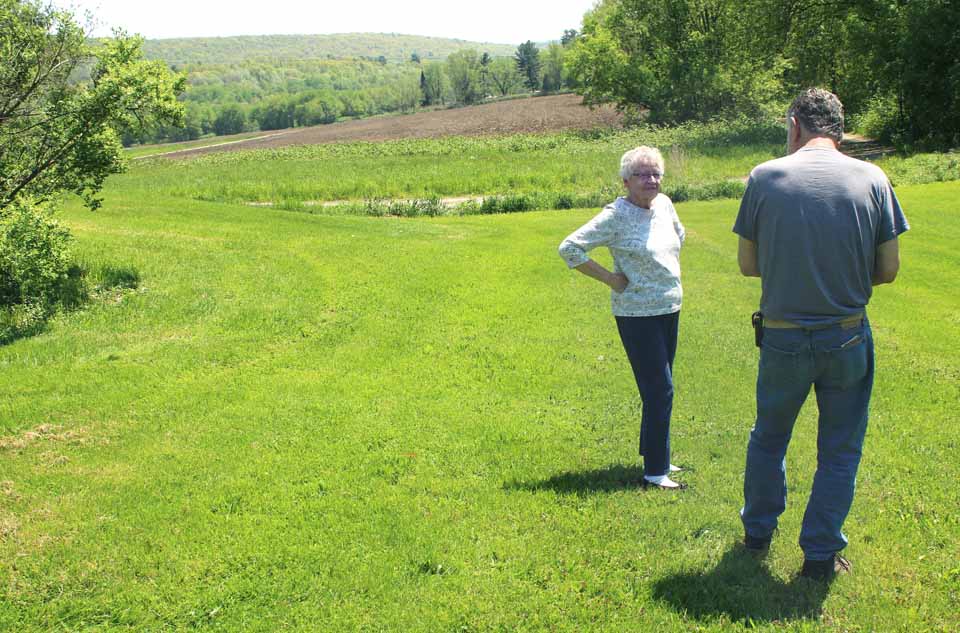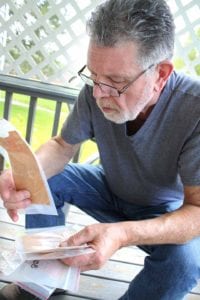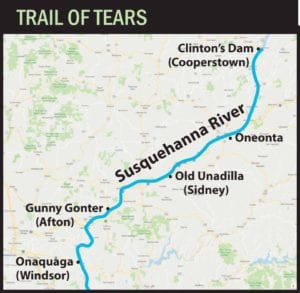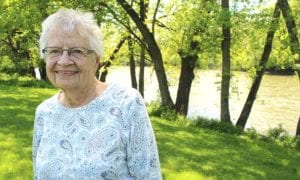ONAQUAGA REDISCOVERED • PART I
Expert Believes
He’s Discovered
HQ Of Iroquois
Buzz Hesse Also Found ‘Old Unadilla’

By JIM KEVLIN • Special to www.AllOTSEGO.com

WINDSOR – There’s an island, a mountain, a curve in the river, flatlands and, up the road, a site that’s long been reported as a mission/trading post set up by Sir William Johnson, Great Britain’s last governor general of the Province of New York.
The flat land along the shore of the Susquehanna would be ideal for Iroquois longhouses. “That’s exactly what the map shows – a little rectangle of houses,” said Buzz Hesse, who before opening Hesse Auctions in Otego was with the Office of the State Archaeologist under his mentor, Dr. Robert Funk.
Mystery solved: After decades of uncertainty, Hesse Sunday, May 19, believed was looking for the first time at was the site of the village whose dispersal signaled the beginning of the end of the famed six-tribe Iroquois Confederacy.
Onaquaga is linked to Otsego County through Gen. John Clinton’s famous damming the Susquehanna River at Cooperstown; he blew it up on Aug. 9, 1779, and his 200-bateaux force was carried down the river to Onaquaga, destroyed the year before.
Clinton’s one brigade from Albany would reconnoiter with Gen. John Sullivan’s four brigades coming up from Pennsylvania on a campaign that would pacify Central New York, allowing Yankees to pour westwards from New England on a century-long quest to control the continent.
It’s particularly newsworthy this weekend, as Friday-Monday, May 24-27, some 3,000 canoes will be paddled from Cooperstown to Bainbridge in the 56th annual General Clinton Regatta.

Until last Sunday, Hesse was uncertain precisely where Onaquaga was. But now he’s sure, after a day spent knocking on doors and talking to neighbors.
Later in the day, Hesse located the tract’s owner, Glenn Winsor, Colesville town supervisor and co-proprietor with brother Al of the expansive Winsor Farms dairying operations, who gave him permission to begin archaeological explorations.
(Hesse asked that the precise location of the site be protected, to discourage marauders.)
If the suspected site is actually the headquarters of the Iroquois Confederacy, Hesse would expect to find tools for making pewter balls used in muskets; the tribes had moved beyond “bows and arrows” by that point.
Also in evidence would be “trade materials” from William Johnson’s nearby trading post/mission: blacksmith-made iron axes, copper items, glass points, “knapped,” and the natives had previously done with flint, and silver items made by craftsmen in Montreal.
Exploring the Onaquaga site would bring Buzz Hesse full circle: It was he in 1968 who discovered the Iroquois village of Old Unadilla at Sidney. The owner, Egli Machine Co., was about to erect a building on the site, and Hesse assembled an archaeological team that in two days, plus two rainy days that followed, was able to establish a record on what was there.
“To document THIS site’s history for posterity – it would be very exciting,” said Hesse.
In addition to Unadilla and Onaquaga, there was a third Iroquois community, Gunny Gonter on an island in the Susquehanna around Afton, but its remains have yet to be located.
Names vary, Hesse said. Unadilla was “Tunadilla” in one of Mohawk Chief Joseph Brant’s letters. Gunny Gonter was “Cunahunta” in Frederick Cook’s “General John Sullivan’s Indian Expedition of 1779,” (1887).
Onaquaga was variously called “Ogwaga” and “Onaqaga.” (From the Mohawk, “place of wild grapes.”)
For the last half-century, archeological enthusiasts were afraid to go there.
The root of that was in the the late 1960s and early ’70s, when historian Marjorie Hinman founded the Old Onaquaga Historical Society, and developed a plan that included an archaeological assessment and re-creation of the longhouses on the original location, said Jerry Smith, recently retired Broome County historian. Mrs. Hinman passed away in 2014.
The key farmer, Roland Springsteen, who was growing potatoes then dairying there, was told he could be caretaker of the ensuing development, an idea that so angered him that he prohibited anyone from coming on the property for a half-century, according to his wife, Janice, 91, interviewed the other day.

“We’ve chased so many people away here,” she said.
The husband passed way in 2011, but by then interest had waned. Jerry Smith isn’t aware of any current plans, either locally or in SUNY Binghamton’s Public Archaeology Facility, for the site.
Affirming Hesse’s conclusions and the map in Frederick Cook’s book, Smith said Onaquaga straddled the river, and also that it shifted up and down the shoreline seven miles or so, responding to flooding or farmland depletion.
Whatever the precise location of Onaquaga, there are plenty of artifacts in the neighborhood, said Mrs. Springsteen. “My husband could ride out on the tractor and spot an arrowhead,” she said.
In one locally celebrated instance in the 1950s, Roland and son Roland Jr. were digging a ditch for a waterline “when the bones of a human, believed to be those of an Indian, were discovered,” according to a newspaper account at the time that Mrs. Springsteen saved.
The Springsteens cooperated with Cornell’s Department of Anthropology, then chaired by Dr. Allen R. Holmberg, an expert in Bolivia’s Siriono Indians who died in 1966. Researchers removed the body to Ithaca for “measurement and study.”
Also up the road is a monument to “Wausaunia” (Rebecca Kellogg Ashley) who, seized as a girl in an Indian raid, acted as interpreter at the “Old Fort,” which Hesse said was likely a trading post/mission William Johnson set up in the vicinity.
A nearby island in the river, Hesse said, was deeded to Brant, the Mohawk chief, after the Revolution, but he only farmed there for a couple of years.
Before the 1778 raid, Onaquaga “was the base of operations for the entire Iroquois Confederacy,” Jerry Smith said. “Despite a historic marker here or there, and DAR plaques from the 1920s,” there’s little recognition today.
Plans are underway nationally for the nation’s semiquincentennial – the 25th anniversary in 2026. “It would be a great time to bring Ononquaga to the forefront,” Smith said.

